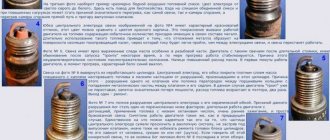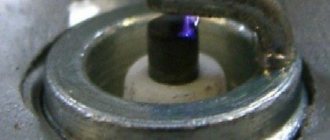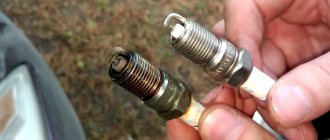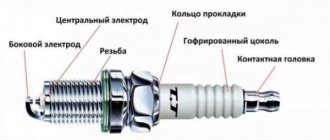Causes of soot
The normal service life of spark plugs is 50 thousand km. Once this milestone is reached, they must be replaced. This is a normal result and cannot be avoided. An interesting fact: you can take excellent care of your car, but plaque will still appear. Their normal color is grey. Minor changes are not scary if the electrodes do not have visible damage. If plaque appears on new spark plugs, then you need to look for the reasons.
Black soot
The most common plaque color, according to user reviews, is black. In this case, it is quite difficult to diagnose a breakdown, since there are two options for black carbon deposits, each of which indicates a problem. The main difference is the structure, which allows you to determine a group of causes of a malfunction. If you observe a uniform, grayish or coffee-colored carbon deposit, your vehicle is in full working order, the engine is running stably, without failures.
Causes of soot formation - why does this happen?
Spark plugs in an internal combustion engine perform the function of timely ignition of the fuel-air mixture. With their help, a spark is created, which ignites the fuel. Due to their design features, the lower part of the spark plugs is always located directly in the combustion chamber of the engine, which is why they experience enormous temperature loads, are subject to constantly high pressure and various chemical processes.
Therefore, over time, carbon deposits form in the lower part of the spark plug, on the insulator or electrodes, and various deposits and darkening may also appear. On a working engine with high-quality spark plugs, carbon deposits, as a rule, have a gray tint. It coats them in an even, dry and light layer. This situation is absolutely normal, especially if the spark plugs have already “run” more than 50 thousand kilometers.
If there are problems with the engine and related systems, the color of the spark plugs may change, and an uncharacteristic dry or spotty coating of red, white or black color begins to form on it. If, after unscrewing the spark plugs on the engine of your car, you find such deposits, you should diagnose the engine, check the ignition timing (ignition timing), the set gaps and other possible causes of deposits, which we will discuss in more detail below.
The nature of the deposit will tell you about the causes of malfunctions
Automotive components are not always coated evenly: one or more parts may turn black. The distribution of soot is also different. The element turns black on one side or carbon deposits appear on the tip or wire.
Black deposits on the spark plug skirt
The bottom of the spark plug housing - the skirt - is always in the cylinder. And carbon deposits on this part prompt a search for causes in the direction of gasoline quality and valve integrity.
Black spark plug in cylinder 4
The spark is stable, but the spark plug in the fourth cylinder is covered with carbon deposits - a typical disease of the domestic “classic”.
Causes:
- hydraulic pushers (if equipped) do not hold pressure;
- The thermal clearance of the valves is incorrect;
- gas distribution in this working chamber is disrupted;
- crack on the valve disc;
- the camshaft cams are worn out;
- the saddle sank.
Remove the valve cover and measure the pressure in the problem cylinder at the end of the compression stroke.
Black spark plug in one cylinder
When a wire burns, the element becomes covered with soot deposits. Do not rule out a malfunction (burnout) of the cylinder itself.
What color is considered normal?
The performance of the gasoline power unit is indicated by spark plug electrodes painted in a light brown tint, without oil deposits and soot. A similar picture is observed in completely new engines and engines that have undergone a major overhaul.
If the color of the working part differs from the specified one, it is advisable to carry out further diagnostics and identify the cause of the problem. Moreover, the engine itself is not always the culprit. What color options are there for spark electrodes:
- light gray or white;
- black;
- brick or frankly red tint.
In addition to all sorts of colors, the candle skirt is covered with various deposits - soot, brown soot, or may simply look wet. These phenomena are also considered signs of various malfunctions. It is proposed to consider each situation in more detail.
Causes
Candles are subject to severe chemical and thermal effects, so their operating environment is perceived as harsh. When fuel combustion occurs on the surface of the electrodes, a grayish, dense coating appears - this condition is considered stable. If the deposit changes color, becomes red, black or greenish, this is a signal to check the operation of the system. Thanks to the shade of the plaque, you can identify the exact cause without disassembling the car. The most common symptoms are poor sparking, breakdown of engine components, low-quality fuel, and incorrect temperature conditions in the aircraft chamber.
Types of carbon deposits on spark plugs
So, the car has driven a certain distance (15-20 km), and if, after unscrewing the spark plugs, it is discovered that the electrodes are light brown, “brick” (the color of red brick), then everything is in order with the engine - the systems are functioning normally, the processes in the chambers combustion is not disturbed.
But this shade does not always happen. Often, after unscrewing, it is discovered that the candles have the following color:
- Black;
- White;
- Red.
In addition to carbon deposits of different colors, traces can be found on the electrodes:
- Gasoline;
- Oils;
- Ash deposits;
- Erosion.
And every discrepancy with the norm has its own reasons. Therefore, a simple inspection of the spark plugs can help in identifying malfunctions or malfunctions of systems and mechanisms, and at an early stage and eliminating them before serious problems arise.
Reasons for the formation of plaque and soot on candles
Black soot and the reasons for its appearance
As already noted, black soot is a consequence of feeding an enriched mixture. But if before the power plant reaches the optimal temperature regime, this mixture ratio is normal, then the detection of velvety black deposits on the electrodes after a long trip indicates the emergence of problems in the operation of the power system. This can happen due to:
- incorrect carburetor adjustment;
- failure in the injection engine ECU;
- sensor malfunctions (as a result of which the control unit begins to operate in emergency mode);
- severely clogged air filter.
A table showing the types of carbon deposits on candles and the reasons for their appearance.
We recommend: How to make a spotter for straightening with your own hands?
White deposits on spark plugs
The white coating on the electrodes of the spark plugs is caused by a very lean mixture. This mixture formation is also incorrect, and it can subsequently lead to very serious problems. Because of this, the combustion process is disrupted, accompanied by the release of increased heat. And this leads to overheating of the combustion chamber, the likelihood of melting of the electrodes and valve edges.
Video: Spark plugs ABC for the inexperienced and self-diagnosis
In a carburetor engine, a lean mixture often occurs due to air leaks in the power system; in an injection engine, such deposits cause the same malfunction in the operation of the ECU. Additionally, the cause of the white color of the spark plugs may be low-quality gasoline. Such deposits are also caused by problems in the ignition system, or more precisely, by a mismatch in the ignition timing.
Red electrodes
Red carbon deposits on candles are not a very common occurrence, and the reason for its appearance lies in gasoline. Unclean fuel suppliers add additives based on metal compounds (most often lead) to gasoline to increase the octane number. During combustion in the cylinders, these additives oxidize and settle in the form of red carbon deposits. In this case, the spark formation of the spark plugs is disrupted, which causes interruptions in the operation of the power plant.
These additives also have a negative effect on other components, therefore, if such deposits are detected, it is not enough to change gasoline; it is advisable to conduct a more in-depth diagnosis of the condition of the power plant using specialized diagnostic equipment.
How to remove black carbon deposits from ignition elements
If black deposits have formed on the spark plugs and in the cylinder, it is not so easy to remove. Still, there are several ways: chemical and mechanical. Both have their pros and cons. Let's take a closer look at each.
Mechanical cleaning method
This method consists of washing the oil, if any, in gasoline. Then the candle is dried and all carbon deposits are removed using sandpaper. It is important to monitor the size of the gap between the electrodes so as not to break it. The efficiency of ignition of the fuel mixture will depend on this. You should be careful, as you can break off the central electrode.
Chemical cleaning method
This method of removing black deposits from spark plugs involves using chemicals. It is highly not recommended to add additives to the internal combustion engine or fuel, even if sellers advise it. There will be more problems from them later. You need to unscrew the spark plugs and wash them in gasoline. Then take the ammonium acetate solution and heat it to 90 degrees along with the candles. For the reaction to react, it is recommended to keep them in the solution for at least 30 minutes. At the end of the procedure, you need to dry and wipe the candles dry. All the carbon deposits will be removed as if by hand.
White deposits on spark plugs
When diagnosing spark plugs, many car enthusiasts expect to see black resinous deposits, soot or something worse, but in 20% of cases the deposits can be white. White deposits on the spark plugs indicate problems with fuel quality and a significant decrease in fuel in the combustion mixture; if the white deposit is a little rough to the touch, if the deposit is glossy, the cause is frequent overheating of the engine. In the first case, the problem is almost non-existent, you just need to clean the spark plug and install it back, it wouldn’t hurt to also change the gas station and gasoline to a high-quality one, in the second case, cleaning is not enough. The main causes of overheating may be:
- Provided that the spark plug is not suitable for this type of engine;
- The inlet pipeline is depressurized, which is why air is often taken in from outside;
- Problems with the cooling system, most often due to untimely replacement of the cooling element;
- Problems with the radiator;
- Poor ignition calibration.
Quite often it happens that the surface does not have a white coating, but a slightly yellowish one, which is typical for problems with an increase in temperature in the combustion chamber when the engine is running at maximum speed. To prevent overheating, you should change gears before the engine reaches 4,000-5,000 rpm.
Frequency of replacement of spark plugs and main causes of plaque
Spark plugs vary in type and destination; in the automotive industry, spark plugs are widely used, the lifespan of which is determined by the type of engine, the type of fuel for the engine and the recommendations of the manufacturer of both the car and the spark plugs. Spark plugs for engines running on reduced natural gas last no more than 10,000 km, while spark plugs for diesel engines should be replaced after 12,000 km, and for gasoline power units after 15-16,000 km, that is, every maintenance.
If problems arise with the engine, the first thing to do is to diagnose the spark plugs, because In 85% of cases, they are the most common cause of vibrations when driving and when the car slightly pulls to the side. You can diagnose the spark plugs yourself using the instructions for replacing spark plugs. By pulling out one of the spark plugs, you can determine by the plaque the type of problem existing in the car system, which is why the spark plug is unable to work properly. The following types of layering on candles are distinguished by color:
The color of soot is the color of the burnt impurity contained in the fuel. Ideally, natural impurities in good fuel are practically not deposited on the spark plugs, except perhaps in the form of light salt deposits, giving a slightly grayish color. It is worth noting that problems in the engine are determined not only by color, but also by the structure and density of carbon deposits (plaque).
What do the different colors of carbon deposits on spark plugs indicate?
Before your trip, don’t be lazy to check the spark plugs. But after warming up the car, you should not turn it off and take them out for inspection; this is a dubious method. A warm engine is greatly enriched in the combustible mixture, and it starts quickly. An oily coating forms on them, but it disappears when passing a certain distance. Inspect them after you have driven more than 200 km. If you take this as a rule, you can avoid breakdowns and eliminate the first manifestations of the problem in a timely manner. Remember that the normal color is light brown. There should be no traces of oil or carbon deposits. If the color is different, there is a problem and the cause needs to be determined.
Checking the condition of the power unit by carbon deposits
Automotive ignition elements remain a good diagnostic indicator if you need to identify problems with the ignition cycle of the fuel mixture. But you should not make an unambiguous conclusion about the condition of the power unit by inspecting the SZ after 25 or more than 1000 km of run. Diagnostics should be carried out exclusively on new products, after a short run-in (150-200 km).
Checking the SZ for the presence of black soot To check for malfunctions in the power unit by the soot formed, you need to:
- Supply new elements in accordance with technical specifications.
- Travel 200 kilometers with them.
- Remove the SZ and look at the shade of soot that appears on them.
Important! It is necessary to check the color of the deposits formed on the elements only on a warm engine.
[custom_ads_shortcode1]
How can you check spark plugs?
Agree that most of us check spark plugs when the first causes of their problems occur. Naturally, this is not the right move for an owner monitoring the operation of his vehicle.
Check the condition of the spark plugs every 5-8 kilometers.
How to eliminate white plaque?
Cleaning spark plugs
One of the most popular methods for eliminating white residue on spark plugs is manual cleaning. But please note that at home, the risk of damaging the insulating coating of the motor is very high. It is worth adding that on damaged insulators, a white coating settles more often than on intact and undamaged ones. Also, do not clean candles with hard or sharp materials. Special brushes or tapes with long and thin connecting wires are best suited.
We recommend: How to upgrade the Niva-21213 stove
How to extend the life of your spark plugs
To prolong the performance of parts, follow some rules. These include the following:
- Do not fill your car with low-quality fuel or engine oil.
- Keep the ignition system in good condition at all times.
- When screwing in the spark plugs, do not overtighten them, find the right balance.
- Buy products that match the characteristics of your car.
A spark plug damaged by low-quality fuel can be restored chemically. If you accidentally pour it in, use the calcination method.
Soot color - what does it mean and what to do?
Take a close look at the spark plugs. Their color will help you understand a lot... For example, you will be able to identify problem areas of the car. It is not enough to just replace the problematic element; look deeper and look for the cause. If it is not corrected, the new spark plug will very quickly become unusable. The problem needs to be cut to the root. The first step is to deal with the ignition system. The next step is to look at the candles. Determine what color the resulting plaque is. Highlight:
- black
- red
- white
Each of them indicates the presence of one or another problem.
Black soot
This type of soot occurs for a number of reasons. There are two subspecies:
- Dry;
- Oily.
Black and dry carbon deposits are applied to the spark plug due to an overly enriched mixture. This could have been preceded by:
- Incorrect carburetor operation;
- Air filter clogged;
- High pressure in the fuel rail;
- Little spark energy;
- Weak compression.
If an oily deposit appears, check that the oil does not get into the combustible mixture. Often the reason is trivial - wear of the oil scraper piston rings. Damage to the valve caps can also affect this.
White plaque
This color appears due to a number of reasons. White deposits on spark plugs can have several shades. Slightly ashy appears when the engine runs on low-quality gasoline. To overcome the problem, remove them, wipe them and they are usable again. Well, monitor the quality of gasoline. But the appearance of shiny soot and erosion on the contact electrodes is a sign of the use of overheated spark plugs. This happens due to an unenriched combustible mixture, early ignition, or a malfunction of the cooling system. Overheating is very dangerous for spark plugs, because it leads to cracks and various types of damage. Most often, this situation requires replacement.
Red and brown soot
As for red (sometimes called brown) soot, its appearance indicates the presence of unnecessary components in the fuel. It is also possible that too many additives have been added to the oil. A color like red brick may also appear if the engine has been running on leaded gasoline for a long time. The surface of the insulator is covered with a brown conductive coating, which disrupts the normal formation of sparks.
Fixing the problem is quite simple - clean the system.
The spark plug does not produce a spark if carbon deposits close the gap between the electrodes. This is a standard situation for cars in which the engine is subjected to high loads for a long time. To solve the problem, replace the spark plugs.
White carbon deposits on the ignition system elements
Spark plugs do not always require immediate replacement; sometimes they can simply be cleaned and the possible cause of deposits can be eliminated. This procedure can be carried out in two ways:
- Mechanical cleaning method. It consists of using simple sandpaper or a small wire brush. Despite the simplicity of the method, it has a number of disadvantages. With such cleaning, the coating on the SZ electrodes can be damaged, and simple scratches can cause increased accumulation of deposits.
- Chemical method. It is more preferable, especially for removing black deposits. The car enthusiast will need to prepare simple cleaning products, a toothbrush and a rag. The elements need to be soaked for about half an hour and then rinsed well. After drying, the candles can be used again.
Automakers provide specific recommendations on how often spark plugs need to be checked and replaced. Let us clarify that the data indicated in the technical documentation is somewhat exaggerated by the manufacturer, and motorists are forced to change them more often than stated. If you suspect wear or poor condition of the spark plugs, you can determine their condition quite easily by carefully examining the shade of soot formed on the surface of the electrodes. This allows you to determine which systems and components of the vehicle lead to incorrect operation of the elements.
https://youtube.com/watch?v=955ageixfoQ
Stable and correct operation of a vehicle engine largely depends on the good functioning of the ignition elements. Periodic inspection will protect your car from serious malfunctions and expensive repairs. It is imperative to carry out a visual inspection of the engine if the engine is not functioning properly or if it is difficult to start.
A gasoline engine cannot live without a spark plug! It is a simple spark gap with central and side electrodes. An arc forms between them, igniting the compressed mixture of fuel and air at the required periods of time.
It is difficult to work as a kind of “match”, since temperature conditions have a wide range. Deposits on the parts of the ignition element and the battery, which can “get tired” both suddenly and during short trips within the city, contribute.
A dark, opaque coating on the electrodes can indicate numerous problems. Before analyzing them, let us divide black formations according to their structure into three independent groups:
- Oily (wet deposits).
- Velvety or loose (dry soot).
- Solid.
The gradation of electrode colors from light gray to white (light yellow is also possible) is evidence that the engine is running on a lean mixture. Related reasons may be:
- The product is too hot. The heat rating of the product is lower than that recommended by the manufacturer.
- Large ignition timing angle.
- Using low octane gasoline.
There is no point in delaying in finding out the circumstances that caused this soot-colored condition on the new spark plug. A lean mixture directly causes overheating of both the igniter and the combustion chamber. Ultimately, this situation can lead to burnout of the exhaust valves.
When analyzing the factors that caused a poor quality mixture, it is useful to check for the presence of abnormal glow ignition. A symptom indicating its presence is the reluctance of the engine to stall when the ignition is turned off. In total, this means that the “match” was not created for this engine.
This conclusion will not be spontaneous if the heat removal from the igniter is not impaired due to loose tightening of the threaded connection, and there is no dirt under the sealing gasket. If this is the case, then you will have to buy a new kit, after consulting the instruction manual.
Black soot - what does it mean?
Black carbon deposits, often coupled with oily stains, are found quite often on both carburetor and injection types of engines. It indicates existing problems in the ignition and engine systems, depending on the type, but the exact cause of its occurrence can be determined after a detailed examination of various parts of the system.
In addition, black soot on a carburetor engine will differ from soot on an injection engine, but if the layer on the insulator is uniform, dry, and the color is closer to gray-brown, then perhaps there is no reason to panic, and the engine is operating normally, and candles gradually exhaust their resource.
The appearance of oily spots on the threads or electrodes is the first sign of oil getting into the combustion chamber. As a rule, thicker smoke with a bluish tint comes out of the exhaust pipe. This may happen due to:
- wear of valve seals or guide bushings;
- wear or sagging of valve piston rings.
If excess oil enters the combustion chamber, the problem lies in the parts of the cylinder-piston group. Perhaps the mobility of the piston rings is reduced, or they have become stuck, or the oil seals and guide bushings need to be replaced. In any case, black candles indicate the need for comprehensive engine diagnostics to determine the specific cause of excess oil.
If there are no oily spots, and a characteristic black soot of a “velvety” type forms on the candles, then most likely more gasoline enters the combustion chamber than necessary, which can also be determined by increased fuel consumption.
We recommend: How to remove rust and bugs from a car body? Means and methods of combating corrosion
In this case, there may be several reasons for the appearance of unwanted plaque:
- incorrect operation of the spark plugs, they do not have enough power to produce the required spark;
- compression in the cylinders is broken;
- problems in carburetor settings (for similar types of engine);
- the air filter is clogged;
- parts of the cylinder-piston group are worn out.
If such deposits are detected, the spark plugs must first be cleaned of carbon deposits or replaced. Next, it is recommended to check the compression in the cylinders, adjust the carburetor, check the fuel level in the carburetor chamber and the jets. On an injection engine, you need to diagnose the injectors, replace the air filter and check the settings and calibrations of the fuel maps, especially if the engine has been chip-tuned.
Features of engine diagnostics using spark plugs
Spark plugs can really “tell” what is happening in the combustion chambers of the engine by the appearance of the electrodes and the presence of carbon deposits on them. But you still need to correctly understand what the candles signal. In addition, such diagnostics require compliance with certain rules, otherwise the data obtained will be unreliable.
The diagnostic process itself couldn’t be simpler. We unscrewed the spark plugs and examined them carefully, and based on how they looked, we found out how the combustion process took place in the cylinders. But if you do not take into account some features, the diagnosis will be far from accurate.
The most reliable data from a candle can only be given after a long trip. But often many drivers act differently. In the morning they start the power plant and, noticing the appearance of interruptions, immediately unscrew the spark plugs.
On the one hand, this action is correct. If the engine does not start (but the starter turns vigorously, and there are no external sounds) or does not work as it should, you should look for the reason in two systems - ignition and power. And naturally, first of all, everyone unscrews the candles. But this allows us to evaluate only the performance of these elements.
But on the other hand, diagnostics based on carbon deposits on spark plugs will be very inaccurate. Until the engine reaches the optimal temperature, an enriched mixture will be supplied to the cylinders, which will ensure the appearance of a fairly strong black soot. Further, if all processes in the cylinders proceed normally, the spark plugs will clean themselves.
That is, on a cold engine, the spark plugs will always have black soot, and you should not take it as a problem. For the information to be as accurate as possible, it is necessary that the engine operates in all modes, so they should be inspected after the trip.
And now to how examining the spark plugs can help in determining the condition of the power plant. Everything is simple here - if there is at least some kind of violation, then soot will form on them, and in a variety of colors, traces of technical fluids or defects may be detected. Based on all this, you can understand what is wrong with the operation of the power plant.
Light electrodes
White or light gray spark plugs in all cylinders are a sign of a lean air-fuel mixture supplied by the injector or carburetor. Moreover, the skirt, area near the electrodes and the threaded part are absolutely dry, without traces of oil.
Why is the fuel mixture supplied lean?
- lambda - the probe incorrectly informs the control unit about the amount of oxygen in the exhaust gases, the reason is sensor wear;
- faulty or clogged nozzles;
- incorrect carburetor settings or clogged fuel jets;
- insufficient pressure in the injector fuel rail;
- problems with the idle air control;
- air leakage under the manifold or in another place;
- unsuccessful chip tuning of the controller made by the owner of the car.
A lean mixture does not pose any particular danger to a running engine, but it does cause discomfort to the driver. The car accelerates slowly, pulls poorly and jerks - there is a lack of fuel. Oddly enough, the phenomenon causes increased gasoline consumption - a car enthusiast who wants to achieve better performance indicators presses the accelerator pedal harder and more often.
Note. Often the light shade of the working electrodes is explained by the type of fuel used. If the car is operated on methane or liquefied gas (propane-butane mixture), this color is considered normal.
Traces of technical fluids on spark plugs
Traces of gasoline are the result of a non-functioning or intermittently functioning spark plug. In this case, a spark does not occur in the cylinder and the fuel simply does not burn, but flies out into the pipe, and also settles on the elements installed in the combustion chamber, including the spark plug.
Strongly visible traces of oil on the electrodes of the spark plugs are the result of excessive amounts of lubricant entering the combustion chambers. This happens in case of severe wear of the cylinder-piston group or oil seals and valve guides. Because of this, oil penetrates into the combustion chamber in unacceptable quantities.
Glossy white
This is one of the most alarming symptoms that should definitely worry the car owner - it signals that the spark plug is not cooling to the required level or the pistons are overheating, which leads to serious consequences - the car will have to be repaired, as cracks may appear in the valve - replacement of the part will cost a hefty sum. There may be several reasons:
- the amount of working fluid for cooling does not correspond to the required level;
- the fuel composition entering the internal combustion chamber is not of suitable quality;
- This results in unnecessary suction of air masses through an intake-type pipeline;
- a snag in debugging the launch - the spark is supplied very early or missed altogether;
- The SZ is not selected correctly for this motor.
If a white accumulation with traces of metal inclusions forms on the surface, it is necessary to send the car for electronic diagnostics. You should not drive your car until the problem is completely eliminated.
Cleaning spark plugs - using proven methods
Timely cleaning of spark plugs allows you to extend their life and stabilize the operation of the ignition system and the engine as a whole. Several methods can be used to clean carbon deposits. The simplest and most convenient is cleaning at home using fine-grained sandpaper or a metal, nylon or even toothbrush. Carefully clean the contaminated surface with a brush, then sand with fine sandpaper. The most important thing is to try not to deeply scratch the surface and not to disturb the established gap between the electrodes, so do not use rough objects (screwdrivers, awls) for cleaning.
The second way to wash off the deposits that have formed is to use available household chemicals and various detergent compositions. Degrease the contaminated surface, then dip the candles in a solution with detergent and leave them for several hours; acetone, vinegar, and household chemicals are well suited for these purposes. To cleanse yellowish or red plaque, you can even use affordable products such as Cola or Sprite. They contain orthophosphoric acid, which facilitates easy cleansing. When using ammonium acetate or another acidic solution, you must first calcinate the candles and heat them to a high temperature, and then sharply lower them into the acid solution for several minutes.
High-quality cleaning of spark plugs can also be carried out in specialized car services. As a rule, they offer cleaning with special ultrasound or sandblasting.











